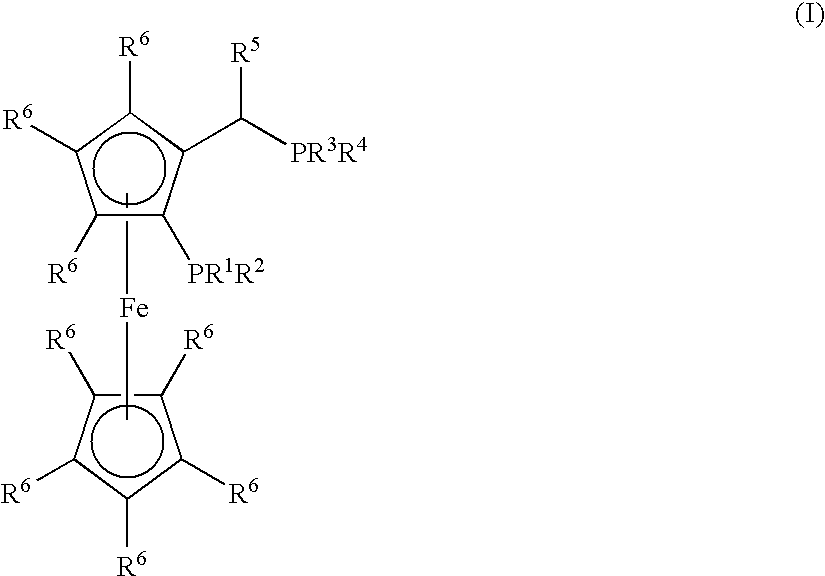Process for the Synthesis of Arylamines from the Reaction of an Aromatic Compound with Ammonia or a Metal Amide
a technology of aromatic compound and arylamine, which is applied in the direction of organic compound/hydride/coordination complex catalyst, physical/chemical process catalyst, iron organic compound, etc., can solve the problem of incompatibility with other functional groups or selectivity, inability to adapt to all substrates, and limited usefulness of the procedur
- Summary
- Abstract
- Description
- Claims
- Application Information
AI Technical Summary
Problems solved by technology
Method used
Image
Examples
example 1
Synthesis of (CyPF-t-Bu)PdCl2
[0168]CyPF-t-Bu (55.4 mg 0.100 mmol) was added to a solution of Pd(CH3CN)2Cl2 (26.0 mg, 0.100 mmol) in CH2Cl2 (5.0 mL). The resulting mixture was stirred for 30 min. at room temperature. The reaction mixture was filtered through a medium fritted funnel containing diatomaceous earth (“Celite®”). The resulting solution was concentrated under vacuum. Crystalline material was obtained by layering with hexane and cooling at −10° C. (65.0 mg, 90%). 1H NMR (CDCl3) δ 4.85 (s, 1H), 4.55 (s, 1H), 4.53 (s, 1H), 4.25 (s, 5H), 3.60-3.75 (m, 1H), 3.00-3.10 (m, 1H), 2.50-2.60 (m, 1H), 2.27-2.90 (m, 1H), 2.13-2.25 (m, 2H), 2.00-2.10 (m, 1H), 1.97 (dd, J=9.0, 7.5 Hz, 3H), 1.70-1.95 (m, 4H), 1.20-1.30 (m, 8H), 1.63 (d, J=13.0 Hz, 9H), 1.30-1.45 (m, 4H), 1.23 (d, J=14.5 Hz, 9H); 31P {1H] NMR (CH2Cl2) δ 113.83 (d, J=9.7 Hz), 31.78 (d, J=9.7 Hz); 13C NMR (CDCl3) δ 96.49 (dd, J=13.3, 5.5 Hz), 71.92 (d, J=2.5 Hz), 69.90 (d, J=9.1 Hz), 69.78, 69.63 (d, J=9.2 Hz), 69.34 (t, J=5...
example 2
4-t-Butylaniline (Table 1, Entry 1)
[0170](CyPF-t-Bu)PdCl2 (7.30 mg, 1.00×10−2 mmol), NaOtBu (0.192 g, 2.00 mmol) and 4-t-butyl-1-bromobenzene (0.213 g, 1.00 mmol) were weighed into a Parr Bomb inside a dry box. DME (20.0 mL) was then added. The Parr bomb was closed and removed from the dry box. Ammonia was added with stirring by connecting to an ammonia tank and maintaining the pressure at 80 psi for 30 min. The resulting reaction mixture was allowed to stir for 24 h at 90° C. Pressure was built up to 200 psi during the reaction. The reaction mixture was then cooled to room temperature before being poured into ice water (20.0 mL). To this mixture was added HCl aqueous solution (10.0 mL, 1.0 M)). The mixture was stirred at room temperature for 5 min and was then neutralized with a saturated solution of NaHCO3 (5.00-10.0 mL). After extraction with CH2Cl2 (3×20.0 mL), the organic layer was separated and dried over MgSO4. The solvent was evaporated, and the crude product isolated by elu...
example 3
o-Toluidine (Table 1, Entry 3)
[0171]2-Chlorotoluene (0.126 g, 1.00 mmol), (CyPF-t-Bu)PdCl2 (7.30 mg, 1.00×10−2 mmol), and NaOtBu (0.192 g, 2.00 mmol) in 20.0 mL DME gave 73.6 mg (69%) of o-toluidine as a colorless liquid (hexane / ethyl acetate: 70 / 30). 1H NMR (CDCl3) δ 7.08 (d, J=6.4 Hz, 1H), 7.07 (t, J=6.4 Hz, 1H), 6.74 (t, J=6.0 Hz, 1 H), 6.70 (d, J=6.0 Hz, 1H), 3.62 (s, br, 2H), 2.19 (s, 3H); 13C NMR (CDCl3) δ 144.41, 130.36, 126.87, 122.26, 118.57, 114.88, 17.25.
PUM
| Property | Measurement | Unit |
|---|---|---|
| Temperature | aaaaa | aaaaa |
| Temperature | aaaaa | aaaaa |
| Temperature | aaaaa | aaaaa |
Abstract
Description
Claims
Application Information
 Login to View More
Login to View More - R&D
- Intellectual Property
- Life Sciences
- Materials
- Tech Scout
- Unparalleled Data Quality
- Higher Quality Content
- 60% Fewer Hallucinations
Browse by: Latest US Patents, China's latest patents, Technical Efficacy Thesaurus, Application Domain, Technology Topic, Popular Technical Reports.
© 2025 PatSnap. All rights reserved.Legal|Privacy policy|Modern Slavery Act Transparency Statement|Sitemap|About US| Contact US: help@patsnap.com



